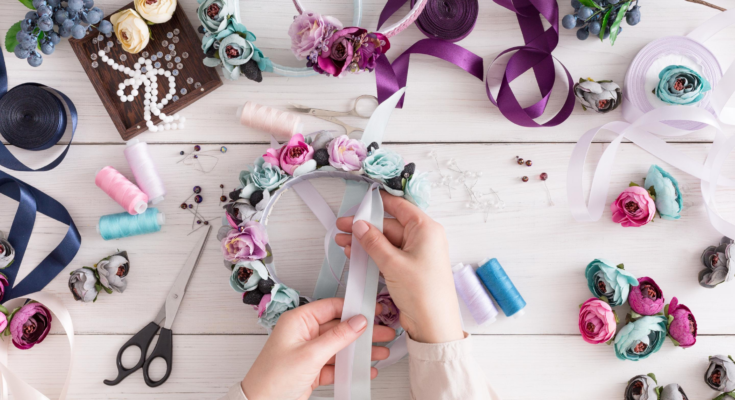Disclosure: This post may contain affiliate links. I earn a small commission when you click a link and make a purchase. Thanks for supporting SewingSociety.com!
Good product photos make a huge difference in the success of your handmade business.
Think about it…
People keep scrolling through Facebook, Pinterest, Etsy, and other websites until something catches their eye. That’s why product photos are so important! They are what initially gets people to click through to your store and browse what you have to offer.
When you run an online shop, customers can’t go to a store to check out your products. They can’t pick them up and inspect them from every angle. Your photos must do all this work.
Now, I know what you’re thinking…
You don’t have tons of money to spend on a good DSLR camera and you don’t have years to master product photography and editing. While a good camera and a photography class can help, they are not essential. You can take great photos with the camera on your phone and some good lighting. Then, you can edit your photos with simple software, like Canva.
If your photos are not good, you’re probably not going to make any sales. Learning how to take better product photos can make all the difference. Here are four things to keep in mind for all of your future photoshoots.
Lighting Is the Most Important Element
Your product photos are not going to turn out well if you simply place your products on a table in a dark room and start snapping… You need to provide proper lighting to minimize harsh shadows and to accurately showcase the color of your products. Lighting is the most important element of a good photo.
I’m sure you’ve heard that photographing your products in natural sunlight is best, but I don’t think that is entirely true. Sunlight is inconsistent — sometimes clouds add shadows and the sun is brighter at different times of the day. However, you can mimic natural sunlight with a lightbox.
A lightbox allows you to control the light and shadows in your product photos. It works by shining diffused light on your products from every angle. With a daylight lightbulb, you can avoid yellow and blue color distortion and make your product photos consistent across your brand.
You Don’t Need an Expensive Camera
DSLR cameras are great. I’m not saying you shouldn’t invest in one to take product photos. However, it’s not essential. You’re better off spending your money on a lightbox and investing money into other areas of your business.
Most smartphones have great cameras that will work well for product photos. Some smartphone cameras are even better than some of the point-and-shoot cameras you can find on the market. I also love that smartphone cameras don’t require any special skill to use.
Staging Is About More Than Props
When you’re selling products online, customers can’t physically handle and examine what you’re offering. Your product photos must do all this work for them. That means the more photos you have of your products, the better.
Your photos should show all the features of your products. You can achieve this by taking photos at every angle and doing some close-up shots of the details. It’s also helpful to take photos with a model using your products. This helps speak to your customers’ emotions.
In most cases, a seamless white background is best for product photos. You don’t need to add props to your photos unless they help with branding or show the features of your products better. Your products are what need to be the focus! Any props or models you use should be carefully planned to not distract from your products.
Photo Editing Software Makes All the Difference
Once you take your photos, you’re not done yet. Then you need to do some editing to really make them appeal to customers. This can include things like adding your logo, borders, and even animations! If your photos don’t stand out, people are never going to stop scrolling and actually click through to look at your products. Photo editing makes all the difference.
Adobe Photoshop and Lightroom is one of the best software programs available for editing photos. You can do almost anything you can imagine to photos. However, Photoshop is not for beginners. You’ll need to take a class to master all the photo editing techniques.
Canva is a user-friendly alternative to Photoshop, especially if you want to make branded social media images to go with your product photos. Canva has a free version, but the paid plan has some really cool photo editing features that you’d love, such as the ability to remove backgrounds from your images. I use Canva all the time on this blog and I love it!
If you’re really interested in learning how to edit photos in Adobe Photoshop and Lightroom, I suggest you take Candace Stringham’s course, Craft Photography Fundamentals. She teaches you everything you need to know to take photos that really showcase the story behind your work and then edit them in a way that entices customers to make a purchase.
With some planning, you truly can take better product photos and sell more handmade items. If you found this post helpful, please share it on Pinterest!






Blur Background Photo Editor & Blur image Background Effect on image effective blurry background app to give your picture DSLR blur effect.